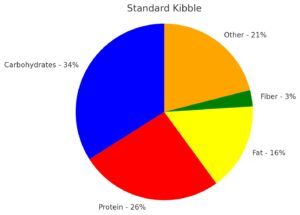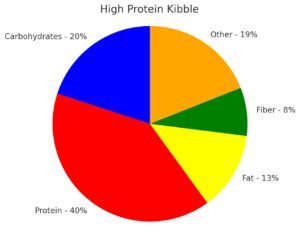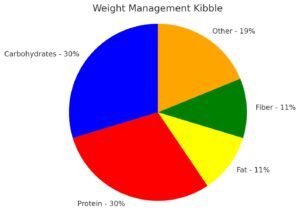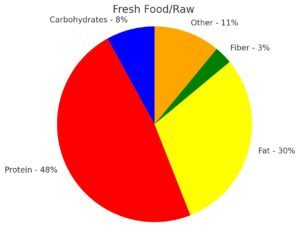When it comes to feeding my dog, I take a deep interest in understanding what goes into their bowl. It isn’t just about following trends; it’s about knowing the science behind dog nutrition. Dogs, like humans, need a balance of proteins, fats, carbohydrates and fiber. However, their needs are distinct, and their diet must cater to their species-specific requirements.
Natural dog foods come into play by aiming to mirror a dog’s ancestral diet. A balanced meal for a dog should include ample protein, essential fats, some fiber, and, in a few cases, a moderate amount of carbohydrates. Although carbohydrates are not a required nutrient in a dog’s diet, they can serve as a beneficial source of energy, especially when derived from vegetables. Vegetables are a good source of fiber as well.
The benefits of natural dog foods are extensive, including improved digestive health, leaner body mass, and more energy. Quality natural dog foods prioritize ingredients that are minimally processed and free from artificial additives. When you analyze the label, you’re looking for recognizable whole food ingredients. You’re also checking the balance of the macros to ensure your dog is getting what its body can most naturally use and benefit from.
So, let’s clear up some common myths. Some pet parents believe that dogs need a diet high in grains or other carbohydrate sources to be healthy. However, the truth is, dogs are able to thrive on a diet that’s higher in protein and fats, with carbohydrates playing a minimal role. While carbs can be included for energy, the quality and quantity are key considerations for your dog’s optimal health.
Carbohydrate Conundrum: Decoding the Myth of Essential Carbs in Dog Diets
You’ve probably been led to believe that carbohydrates are a necessary part of your dog’s diet. Look at most dry dog foods on the market, and you’ll see a common denominator: they’re typically high in carbohydrates. It’s such a prevalent notion that we rarely question it. It’s time to re-evaluate the role of carbohydrates in canine nutrition and debunk this belief.
Unlike in humans, where carbohydrates function as a primary energy source, dogs have a different metabolic setup. Their bodies are equipped to generate energy from protein and fat, making carbohydrates a non-essential component. So, why are many commercial dog foods, even those boasting ‘high-protein’ labels, still so starchy?


The answer typically lies in the economics and manufacturing of pet food. Carbohydrates derive from grains or legumes, which are not just cheaper but also act as binders that give kibble its shape and texture. This doesn’t mean carbs are inherently bad for dogs, but it does call for a critical look at their quantity and necessity in your dog’s bowl.
Now, what about those specialized ‘weight management’ foods? Often, they’re also kibble-based, designed to be lower in calories. They indeed contain more fiber, which can help your dog feel full and support digestive health. Yet, paradoxically, they don’t escape the high carbohydrate formulation of regular kibble. It’s a double-edged sword when the very thing meant to help manage weight still relies on high-carb content.

This is not to dismiss the benefits of fiber or certain complex carbohydrates when used judiciously in a dog’s diet. However, the overreliance on carbs in many weight management products is not ideal. An optimal diet should prioritize good quality, minimally processed proteins and fats, and cater to the evolutionary dietary patterns of dogs, not just what’s convenient for shelf-stability or production costs.
Choosing the Right Diet: Comparing Kibble to Fresh and Raw Dog Food Alternatives
When it comes to your dog’s health, the quality and type of food they consume plays a pivotal role. Let’s consider the facts: kibble, a common choice for convenience and cost, is often laden with higher levels of carbohydrates than necessary for canines. This holds true even for those billed as high-protein or weight management options.
A shift towards fresh or raw diets can mark a significant turn in your dog’s nutritional journey. These diets typically boast lower carbohydrate content and quality protein that hasn’t been subjected to the rigors of high-processing, meaning the nutrients are more intact and readily available for your dog’s system to utilize.

But what exactly does this look like in practice? Fresh diets are often composed of whole foods, allowing for easier digestion and better nutrient absorption. Raw diets, while a topic of debate, are said to mimic a dog’s ancestral eating habits, promoting a balanced intake that aligns more closely with their natural dietary needs.
The evidence suggests that these less processed options contribute to better weight management and can even alleviate certain health issues stemming from high-carb diets, like obesity and hormonal dysfunction. Always remember, every dog is unique, and what works for one may not work for another. Consulting with a veterinarian can help you make an informed choice that supports the health, lifestyle, and longevity of your furry friend.
When considering kibble, fresh, or raw diets, it’s crucial to focus on the nutrients rather than just the category of food. Pay close attention to the macro balance, the processing level of proteins, and ultimately, how the food benefits your dog’s unique health profile. Making these careful considerations can lead to a happier, more energetic, and healthier companion by your side. Thriving over surviving!